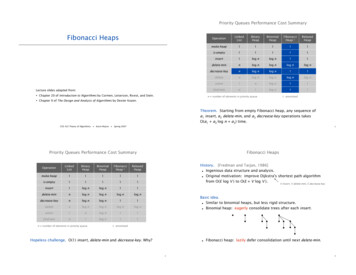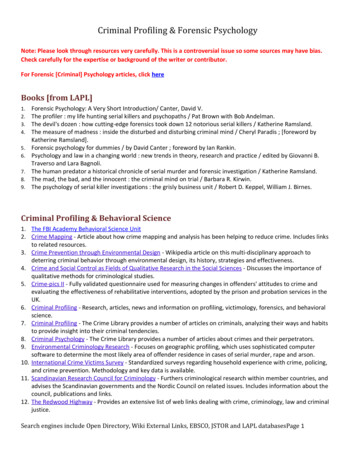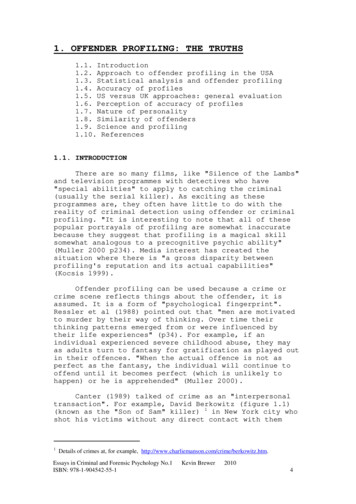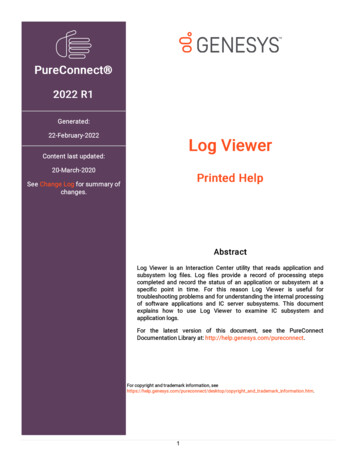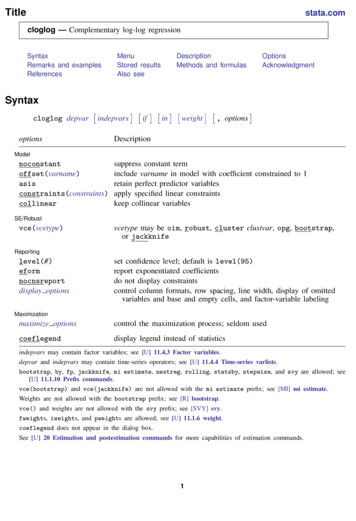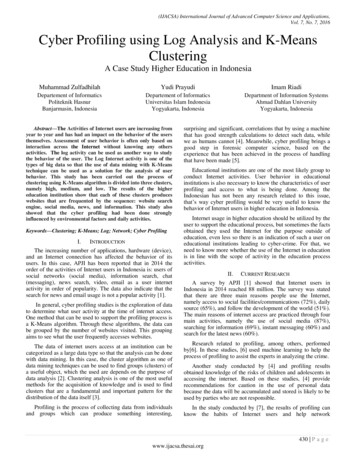
Transcription
(IJACSA) International Journal of Advanced Computer Science and Applications,Vol. 7, No. 7, 2016Cyber Profiling using Log Analysis and K-MeansClusteringA Case Study Higher Education in IndonesiaMuhammad ZulfadhilahYudi PrayudiImam RiadiDepartement of InformaticsPoliteknik HasnurBanjarmasin, IndonesiaDepartement of InformaticsUniversitas Islam IndonesiaYogyakarta, IndonesiaDepartment of Information SystemsAhmad Dahlan UniversityYogyakarta, IndonesiaAbstract—The Activities of Internet users are increasing fromyear to year and has had an impact on the behavior of the usersthemselves. Assessment of user behavior is often only based oninteraction across the Internet without knowing any othersactivities. The log activity can be used as another way to studythe behavior of the user. The Log Internet activity is one of thetypes of big data so that the use of data mining with K-Meanstechnique can be used as a solution for the analysis of userbehavior. This study has been carried out the process ofclustering using K-Means algorithm is divided into three clusters,namely high, medium, and low. The results of the highereducation institution show that each of these clusters produceswebsites that are frequented by the sequence: website searchengine, social media, news, and information. This study alsoshowed that the cyber profiling had been done stronglyinfluenced by environmental factors and daily activities.Keywords—Clustering; K-Means; Log; Network; Cyber ProfilingI.INTRODUCTIONThe increasing number of applications, hardware (device),and an Internet connection has affected the behavior of itsusers. In this case, APJI has been reported that in 2014 theorder of the activities of Internet users in Indonesia is: users ofsocial networks (social media), information search, chat(messaging), news search, video, email as a user internetactivity in order of popularity. The data also indicate that thesearch for news and email usage is not a popular activity [1].In general, cyber profiling studies is the exploration of datato determine what user activity at the time of internet access.One method that can be used to support the profiling process isa K-Means algorithm. Through these algorithms, the data canbe grouped by the number of websites visited. This groupingaims to see what the user frequently accesses websites.The data of internet users access at an institution can becategorized as a large data type so that the analysis can be donewith data mining. In this case, the cluster algorithm as one ofdata mining techniques can be used to find groups (clusters) ofa useful object, which the used are depends on the purpose ofdata analysis [2]. Clustering analysis is one of the most usefulmethods for the acquisition of knowledge and is used to findclusters that are a fundamental and important pattern for thedistribution of the data itself [3].Profiling is the process of collecting data from individualsand groups which can produce something interesting,surprising and significant, correlations that by using a machinethat has good strength calculations to detect such data, whilewe as humans cannot [4]. Meanwhile, cyber profiling brings agood step in forensic computer science, based on theexperience that has been achieved in the process of handlingthat have been made [5].Educational institutions are one of the most likely group toconduct Internet activities. User behavior in educationalinstitutions is also necessary to know the characteristics of userprofiling and access to what is being done. Among theIndonesian has not been any research related to this issue,that’s way cyber profiling would be very useful to know thebehavior of Internet users in higher education in Indonesia.Internet usage in higher education should be utilized by theuser to support the educational process, but sometimes the factsobtained they used the Internet for the purpose outside ofeducation, even less so there is an indication of such a user oneducational institutions leading to cyber-crime. For that, weneed to know more whether the use of the Internet in educationis in line with the scope of activity in the education processactivities.II.CURRENT RESEARCHA survey by APJI [1] showed that Internet users inIndonesia in 2014 reached 88 million. The survey was statedthat there are three main reasons people use the Internet,namely access to social facilities/communications (72%), dailysource (65%), and follow the development of the world (51%).The main reasons of internet access are practiced through fourmain activities, namely the use of social media (87%),searching for information (69%), instant messaging (60%) andsearch for the latest news (60%).Research related to profiling, among others, performedby[6]. In these studies, [6] used machine learning to help theprocess of profiling to assist the experts in analyzing the crime.Another study conducted by [4] and profiling resultsobtained knowledge of the risks of children and adolescents inaccessing the internet. Based on these studies, [4] providerecommendations for caution in the use of personal databecause the data will be accumulated and stored is likely to beused by parties who are not responsible.In the study conducted by [7], the results of profiling canknow the habits of Internet users and help network430 P a g ewww.ijacsa.thesai.org
(IJACSA) International Journal of Advanced Computer Science and Applications,Vol. 7, No. 7, 2016administrators to improve the quality, security, and policy inthe Internet network based on user behavior.Meanwhile, [8] have also been doing profiling of Facebookusers using the inductive method. However, the study alsorevealed that cyber profiling still has to use the deductivemethod because the cyber profiling process still requiresadditional data from the user completely. It to support theexistence of differences in the behavior of individuals, becauseinductive generalizations extremely unreliable, and may causemisunderstanding in the analysis.Another study conducted by [9] to use Twitter usingontology-based modeling OWL (Web Ontology Language), itis known that cyber profiling can be used to determine userinterest based on URLs that have been shared via Twitter. Theuse of ontology also applied by [10], and the study revealedthat cyber profiling using these methods could facilitate inproviding information to the user when performing a search ona website.III.BASIC THEORYA. Data MiningData mining is an iterative and interactive process to find anew pattern or model valid, useful and understandable in a verylarge database. Data mining provides the search for patterns ortrends that are desirable in a large database to help makedecisions in the future. This pattern is recognized by aparticular device that can provide a useful analysis andinsightful data that can then be studied more carefully. Theresults of these patterns may be used in devices other decisionsupport [2]. Data mining has stages like in Figure 1.TransformationEvaluation andPresentationDataMiningknowledge4) Association rule learning – search the relationshipbetween variables. For example, a supermarket might gatherdata on customer habits. Association rule learning can helpsupermarkets to determine which products are frequentlybought together and use this information for marketingpurposes. This is sometimes referred to as market basketanalysis.B. K-MeansClustering is used to create a group (cluster) of the data sothat it can easily find the necessary data. Clustering is aclassification of similar objects into several different groups, itis usually applied in the analysis of statistical data which canbe utilized in various fields, for example, machine learning,data mining, pattern recognition, image analysis andbioinformatics [11].Clustering including supervised learning types. There arefour types of clustering algorithms that have been comparedbased on performance, such as K-Means, hierarchicalclustering, self-organization map (SOM) and expectationmaximization (EM Clustering). Based on these test results canbe concluded that the k-means algorithm performance and EMbetter than a hierarchical clustering algorithm. In general,partitioning algorithms such as K-Means and EM highlyrecommended for use in large-size data. This is different froma hierarchical clustering algorithm that has good performancewhen they are used in small size data [12].The method of K-means algorithm as follows [13]:1) Determine the number of clusters k as in shape. Todetermine the number of clusters K was done with someconsideration as theoretical and conceptual considerations thatmay be proposed to determine how many clusters.2) Generate K centroid (the center point of the cluster)beginning at random. Determination of initial centroid done atrandom from objects provided as K cluster, then to calculatethe i cluster centroid next, use the following usePatternv TransformedData xi 1; i 1,2,.,ni(1)nv : cluster centroidxi : the object to-in : the number of objects to be members of the clusterDatabase3) Calculate the distance of each object to each centroidof each cluster. To calculate the distance between the objectwith the centroid author using Euclidian Distance.Fig. 1. Data Mining Process [10]Data mining involves four tasks [11]:1) Clustering – It is the task of finding a group andstructure the data in some way or the "similar", without usingknown structures in the data.2) Classification – It is the task of generalizing knownstructure to apply to new data. For example, an email programto attempt to classify an email as legitimate email or as spam.3) Regression – Attempts to find a function which modelsthe data with the least error.d ( x, y) x y n (x y )j 1xi object x to-ii2i(2)n the number of objectyi object y to-i4) Allocate each object into the nearest centroid. Toperform the allocation of objects into each cluster during theiteration can generally be done in two ways, with a hard Kmeans, where it is explicitly every object is declared as a431 P a g ewww.ijacsa.thesai.org
(IJACSA) International Journal of Advanced Computer Science and Applications,Vol. 7, No. 7, 2016member of the cluster by measuring the distance of theproximity of nature towards the center point of the cluster,another way to do with fuzzy C-Means.5) Do iteration, then specify a new centroid position usingequation (1).6) Repeat step 3 if the new centroid position is not thesame.C. LogLog (record keeping) is a file that records events in thecomputer program. Meanwhile, according to the definition ofthe log is a record of daily activities. Activities that arerecorded directly called the transaction log. The log file can beused as a support in the process of cyber forensics to obtaindigital evidence during the investigation stage [14].The cleaning process must precede analysis of log data orpreprocessing. Preprocessing is performed to removeduplication of data, check the data inconsistency, and correcterrors in the data, such as print errors (typography) [15].In Table 1 is an example of data on educational institutionsTABLE I.EXAMPLES OF DATAthe alleged offenders through the analysis of data patterns thatinclude aspects of technology, investigation, psychology, andsociology.Cyber Profiling process can be directed to the benefit of: Identification of users of computers that have been usedpreviously. Mapping the subject of family, social life, work, ornetwork-based organizations, including those for whomhe/she worked. Provision of information about the user regarding hisability, level of threat, and how vulnerable to threats Identify the suspected abuserIn a broader scope of cyber profiling can provide supportinformation in a case, such as counterintelligence andcounterterrorism [5].The process of profiling against criminals often also knownas cyber-criminal profiling criminal investigation or analysis.Criminal profiles generated in the form of data on personaltraits, tendencies, habits, and geographic-demographiccharacteristics of the offender (for example: age, gender, socioeconomic status, education, origin place of residence).Preparation of criminal profiling will relate to the analysis ofphysical evidence found at the crime scene, the process ofextracting the understanding of the victim (victimology),looking for a modus operandi (whether the crime sceneplanned or unplanned), and the process of tracing theperpetrators were deliberately left out (signature) [16].The new approach to cyber profiling is to use clusteringtechniques to classify the Web-based content through data userpreferences. This preference can be interpreted as an initialgrouping of the data so that the resulting cluster will show userprofiles [17].D. Cyber ProfilingThe idea of cyber profiling is derived from criminalprofiles, which provide information on the investigationdivision to classify the types of criminals who were at thecrime scene. Profiling is more specifically based on what isknown and not known about the criminal [8].Profiling is information about an individual or group ofindividuals that are accumulated, stored, and used for variouspurposes, such as by monitoring their behavior through theirinternet activity [4].Difficulties in implementing cyber profiling is on thediversity of user data and behavior when online is sometimesdifferent from actual behavior. Given the privilege in personalbehavior, inductive generalizations can be very reliable but canalso lead to a misunderstanding of behavior analysis. Thereforethe cyber-profiling process is via a combination of deductiveand inductive methods [8].For investigation, the cyber-profiling process gives a good,contributing to the field of forensic computer science. CyberProfiling is one of the efforts made by the investigator, to knowUser profiling can be seen as the conclusion of the interestsof users, intentions, characteristics, behavior and preferences[9]. User profiles are created for a description of thebackground knowledge of the user. User profile represents aconcept model which is owned by the user when searching forinformation web [18].IV.RESEARCH METHODSTo determine cyber-profiling of the higher educationalinstitutions, so in this study the sample data is a log of Internetactivities from one educational institution. Log data do not onlycontain any websites accessed by the user, but also includespackets received and sent over the network traffic. Dataobtained containing the activities of network traffic for fivedays and produce data as much as 320.773 records.In the early stages of research data collection, then dopreprocessing that the data did not meet the criteria can beeliminated. Preliminary data obtained from 320.773 into a1.638 record with the results of preprocessing. Furthermore,the mechanism of clustering using K-Means algorithm runningon Rapid Miner and SPSS applications. The cluster data is thenanalyzed to make the process of profiling against internet users.432 P a g ewww.ijacsa.thesai.org
(IJACSA) International Journal of Advanced Computer Science and Applications,Vol. 7, No. 7, 2016Figure 2 is a flow of the application of K-Means algorithmin the profiling process.StartDataCollectionV.RESULTA. K-Means ClusteringImplementation of the K-Means algorithm, the resultobtained is a level of visits to the website. The visit is dividedinto three groups: low, medium, and high.Clustering by Rapid Miner and SPSS application indicatesthat the output produced has the same cluster of data. Based onthe results of the cluster, it appears there are three clusterswhose value is different, even on the first cluster value reachedin 1479 (90.30%), the second is worth 126 (7.70%), and thethird is worth 33 (2.00%). Those values represent the numberof websites that have been divided in each cluster. Clusteringresults have shown this process has been running as expectedto tion of the initial cluster center in the clusteringprocess can be seen in Table 2.K-MeansResultTABLE II.INITIALIZATION BEGINNING CLUSTER CENTERClusterNumber of VisitorsCyber ProfilingProcess371The new centroid calculations will continue to do(iteration) until the discovery of iterations where centroid resultis the same as the results of the previous centroid. In this study,there were eight iterations to determine the exact outcome ofthe 1638 cluster object. The iteration process can be seen inTable 3.Fig. 2. Flow ResearchFigure 3 is a flow of the algorithm K-Means:StartTABLE III.Inisiation ofK; K 3Iteration12345678Inisiation K Centroid based on Min,Median, Max value of datasetCalculate distance of datafrom each K CentroidCLUSTERING PROCESSChanges In Cluster 20,0000,1130,4100,0000,0000,000The result of the iteration process in determining the initialclustering center can be seen in Table 4.YesAssigned data on cluster basedminimum distance from KcentroidTABLE IV.NoValidate clusterbased on the densityof the dataEndFig. 3. K-Means Algorithm237An initial value is determined based on the data that havethe highest value, the median value, and the smallest value.Those values are at the center of the initial cluster that will befollowed in the process of K-Means.DoneIs the centroid change11Number of VisitorsFINAL RESULT OF CLUSTER CENTER12Cluster219346The results of clustering details will be explained asfollows: Cluster-1. On the results of clustering that has beendone, the first cluster has as much data as 1467 records.The first cluster has the most members, but this clusterhas a value which is below the overall average of the433 P a g ewww.ijacsa.thesai.org
(IJACSA) International Journal of Advanced Computer Science and Applications,Vol. 7, No. 7, 2016data studied. In the first cluster has a data value in therange of 1-10, because in this cluster of existing datahas a low level of traffic. Thus, cluster unity categorizedon the website that has the least traffic from anothercluster. Cluster-2. In the second cluster, members who enteredat this cluster of some 126 records. The value of theresults of the second cluster is in the range 11-31. Thisvalue indicates that the members of the second clusterhave a medium level visits, because it has a highervalue than the average value generated by clustering.Thus, the second cluster of clusters categorized ashaving moderate traffic levels.Cluster-3. On the results of the third cluster, clustermembers who sign on as many as 33 records. Theresults of this third cluster have the fewest number ofmembers in comparison with other clusters, but themembers of this cluster have the highest value of thedata that has been generated. The value in this cluster isin the 34-63 range, pointing to a result that the thirdcluster has a value far above average. Thus, the thirdcluster is categorized as a cluster that has the highesttraffic levels.The Results of clustering that has been done can be seen inFigure 4.the advertising media website that coincided with a visit to awebsite activity. Meanwhile, in the second cluster that hasmoderate traffic levels, the data indicate a cluster member newssites that are in this cluster.On the results of the third cluster is a group of websiteswith the highest traffic levels, but has the least number ofwebsites. Data in this cluster shows that social media is awebsite with traffic levels were relatively high. Other data fromthe third cluster shows that Internet users access website searchengine more frequently than from other websites includingsocial media websites.Although the research by [19] mention that the K-Meansalgorithm has shortcomings in central initialization beginning,in this study there were no such deficiencies. Clustering by twoapplications, Rapid Miner and SPSS produce the same data,this indicates that the determination of the value of the initialcluster center of these two applications has the same initialvalue.Based on the results of clustering has been obtained thatInternet users in educational institutions often make access towebsite search engine for information related to their field.This study also obtained results, that the social media websiteand streaming video sites accessed more frequently than theinformation and news website. These results caused by thedelivery of information in the digital age now entering therealm of social media compared to other information websites.In this study, social media included in the websitefrequently accessed by the user. This is according to researchconducted by [1] [9] which states that social media becomesone of the surfing activity frequently accessed.Cyber profiling process that has been done shows that thesearch for information more frequently accessed by userscoming from educational institutions. This indicates thatenvironmental factors and daily activities affect on what isaccessed by the user. These results refer to the study [8] whichstates that the process of cyber profiling to predict based on thedemographic information has a high degree of accuracy.Based on the above data profiling results to highereducational institutions indicate that the use of the Internet hasbeen used to support the educational process. The source of thedata obtained showed no user activity in the area of highereducation that leads to cybercrime.Fig. 4. The Result of ClusteringB. Analysis ResultsIn this study, the algorithm K-Means clustering has beenimplemented to perform in line with expectations. In the earlystages of primary data obtained containing information aboutthe websites accessed by users via the internet. In addition tothe data contained informative website also contains data thatupdates to the operating system, the update of the web browser,and website advertising that usually appears as a pop-up.In this case was supposed to complete the profiling resultsas mentioned by [5], the source of data should contain logactivity on a computer that had been used, but in this research,the data has only been in the form of log data network traffic.Based on the results of the K-Means as shown in Figure 4indicate that each cluster obtained having a different number ofsignificant cluster members.The results of this research have been able to meet thedefinition of cyber profiling, because it provides informationabout the user based on the current activity connected with theinternet. The results of this study can be used by networkadministrator to improve the quality of services, policies, andsecurity as mentioned by [7].In the first cluster have shown low levels of traffic, but hassome websites most. Data on the first cluster contains most ofIn this study cyber profiling can only provide informationabout the Internet activities performed by users, but for thethreat of crime and profiling based on data from computers thathave been used as mentioned by [5] are still not exist.434 P a g ewww.ijacsa.thesai.org
(IJACSA) International Journal of Advanced Computer Science and Applications,Vol. 7, No. 7, 2016VI.CONCLUSIONThe results of log analysis datasets using the K-Meansalgorithm to cyber profiling process show that the algorithmhas to group activity based on the data of internet users visitedthe website. This grouping is divided into three, namely thevisit low, medium, and high.In this study, the K-Means algorithm is used as analgorithm for the cyber profiling process. K-Means algorithmbeing used is in line with expectations from this study, becauseit has a simple algorithmic process with a good degree ofaccuracy. But the K-Means algorithm has disadvantages,namely the process of making an initial value initial randomcenter. This can lead to differences in the results of the cluster.The results of this study indicate that Internet users inhigher educational institutions are more accessible to websitefor searching information. The results also show that socialmedia has a high-level visit after website search engine.This study has limitations in the source of data for theprofiling process. For the perfection of the profiling, theprocess should contain the data of any computer activities.Therefore, further research is expected to perform better cyberprofiling with the more complete data source.[1][2][3][4]REFERENCESAPJII, “Indonesian Internet User Profile 2014,” 2015.Fajar Astuti Hermawati, Data Mining. Yogyakarta: CV. Andi Offset,2013.H. Chunchun, L. Nianxue, Y. Xiaohong, and S. Wenzhong, “Traffic FlowData Mining and Evaluation Based on Fuzzy Clustering Techniques,”vol. 13, no. 4, pp. 344–349, 2011.D. B. van den Berg, P. dr. A. de Vries, P. dr. S. van der Hof, M. ][17][18][19]and A. Theocharidis, “Online Identities , Profiling and Cyber Bullying,”no. March, 2013.J. J. Irvine, “Digital Forensic Analysis & Cyber Profiling,” no. 703, pp.1–32, 2010.A. S. N. Chakravarthy, “Analysis of cyber-criminal profiling and cyberattacks : A comprehensive study,” no. September, 2014.T. Bakhshi and B. Ghita, “Traffic Profiling : Evaluating Stability inMulti-Device User Environments,” 2016.S. Yu, “Behavioral Evidence Analysis on Facebook: a Test of CyberProfiling,” Defendologija, vol. 16, no. 33, pp. 19–30, 2013.P. Peña, R. Hoyo, J. Vea-murguía, C. González, and S. Mayo, “CollectiveKnowledge Ontology User Profiling for Twitter Automatic UserProfiling,” pp. 439–444, 2013.C. J. Lei Xu, J. Wang, J. Yuan, and Y. Ren, “Information Security in BigData : Privacy and Data Mining,” pp. 1149–1176, 2014.A. Chauhan, G. Mishra, and G. Kumar, “Survey on Data MiningTechniques in Intrusion Detection,” vol. 2, no. 7, pp. 2–5, 2011.I. Riadi, J. E. Istiyanto, and Su. S. Saleh, “Internet Forensics FrameworkBased-on Internet Forensics Framework Based-on Clustering,” no.January, 2013.N. S. Ediyanto, Muhlasah Novitasari Mara, “Characteristics classificationby Method K-Means Cluster Analysis,” Bul. Ilm., vol. 02, no. 2, pp. 133–136, 2013.A. Iswardani and I. Riadi, “Denial Of Service Log Analysis UsingDensity K-Mans Method,” vol. 83, no. 2, pp. 299–302, 2016.Universitas Sumatera Utara, “Decision Tree,” Repos. II.pdf, 2012.Margaretha, “Criminal Profiling dan Psychological criminal-profiling-danpsychological- Autops., 2015.P. B. Costa, S. Oliveira, and L. Nunes, “Profiling Web Users Preferenceswith Text Mining,” pp. 1–4, 2013.P. Jayakumar and P.Shobana, “Creating Ontology Based User Profile forSearching Web Information,” no. 978, 2014.S. Andayani, “Formation of clusters in Knowledge Discovery inDatabases by Algorithm K-Means,” 2007.435 P a g ewww.ijacsa.thesai.org
In these studies, [6] used machine learning to help the process of profiling to assist the experts in analyzing the crime. Another study conducted by [4] and profiling results . The cleaning process must precede analysis of log data or preprocessing. Preprocessing is performed to remove duplication of data, check the data inconsistency, and .
